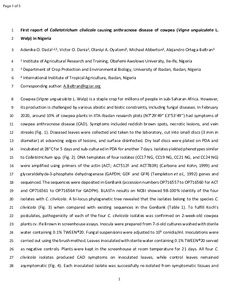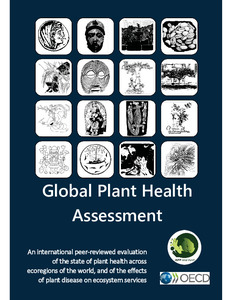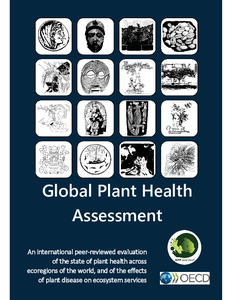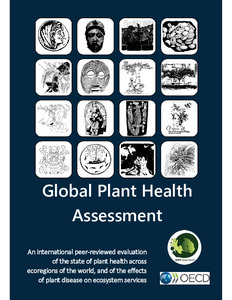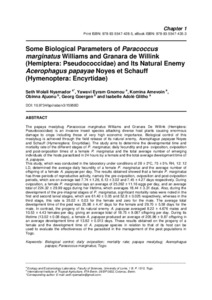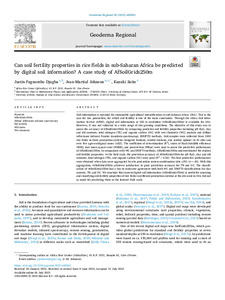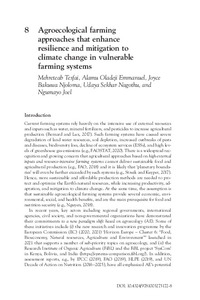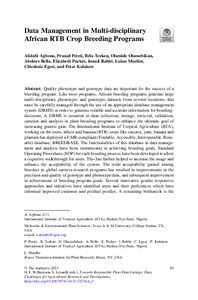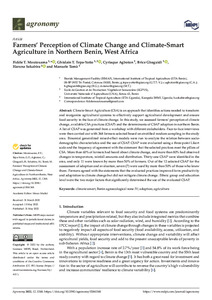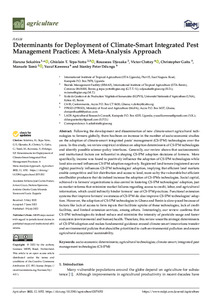Welcome to the International Institute of Tropical Agriculture Research Repository
IITA Bibliography System: Recent submissions
Now showing items 621-640 of 8094
-
Biotechnology approaches in breeding for biotic stress resistance in yam (Dioscorea spp.)
(Springer, 2022)Yam (Dioscorea spp.) is a major staple and cash crop in tropical and subtropical regions. However, biotic (fungus, viruses, tuber rots, nematodes, insects, etc.) and abiotic stresses (drought, low soil fertility, etc.) substantially impact the productivity and quality of yam crop in regions where it is majorly cultivated. Developing and deploying resilient cultivars is a cost-effective and environmentally sound approach to enhance productivity in stressful environments. Breeding initiatives in yam ... -
Marker-Assisted Selection (MAS): untapped potential for enhancing food and nutrition securities in sub-Saharan Africa
(Springer, 2022-11-17)Global food security has raised concerns for the rapidly growing population and extreme weather due to climate change. Conventional plant breeding deployed the current greatly fecund crops, but there must be an increase in the genetic improvement to meet the anticipated future demand. Existing crop breeding techniques and recent technologies could resourcefully be reconnoitered to increase crop improvement in the façade of increasingly perplexing production condition, which is discussed in this ... -
Smallholder farmers' perception and challenges toward the use of crop residues and agro-industrial byproducts in livestock feeding systems in eastern DR Congo
(2022-07)The extent of crop residues and agricultural byproducts utilization for their integration in feeding systems in Eastern DR Congo was assessed in South-Kivu (Walungu territoire) and two territoires in the Tanganyika province (Kalemie and Moba territoires). Data were collected through 21 focus group discussions in which 273 farmers participated including respectively 116 (42%) from South Kivu and 157 (58%) from Tanganyika province. A logistic regression model was used to determine factors influencing ... -
Micro-climatic variations across Malawi have a greater influence on maize susceptibility to aflatoxins than to fumonisins
(2022-11-29)This study reports levels of aflatoxin and fumonisin in maize samples (n = 1294) from all agroecological zones (AEZs) in Malawi. Most maize samples (> 75%) were contaminated with aflatoxins and 45% with fumonisins, which co-occurred in 38% of the samples. Total aflatoxins varied across the AEZs, according to mean annual temperature (P < 0.05) of the AEZs. Samples from the lower Shire AEZ (median = 20.8 µg/kg) had higher levels of aflatoxins (P < 0.05) than those from the other AEZs (median = 3.0 ... -
First report of Colletotrichum cliviicola causing anthracnose disease of cowpea (Vigna unguiculata L. Walp) in Nigeria
(2022-12-21)Cowpea (Vigna unguiculata L. Walp) is a staple crop for millions of people in sub-Saharan Africa. However, its production is challenged by various abiotic and biotic constraints, including fungal diseases. In February 2020, around 10% of cowpea plants in IITA-Ibadan research plots (N7°29'49'' E3°53'49'') had symptoms of cowpea anthracnose disease (CAD). Symptoms included reddish brown spots, necrotic lesions, and vein streaks (Fig. 1). Diseased leaves were collected and taken to the laboratory, ... -
Impact of frequency of application on the long-term efficacy of the biocontrol product Aflasafe in reducing aflatoxin contamination in maize
(2022)Aflatoxins, produced by several Aspergillus section Flavi species in various crops, are a significant public health risk and a barrier to trade and development. In sub-Saharan Africa, maize and groundnut are particularly vulnerable to aflatoxin contamination. Aflasafe, a registered aflatoxin biocontrol product, utilizes atoxigenic A. flavus genotypes native to Nigeria to displace aflatoxin producers and mitigate aflatoxin contamination. Aflasafe was evaluated in farmers’ fields for 3 years, under ... -
Spatial and temporal population dynamics of Aspergillus flavus in commercial pistachio orchards in Arizona
(2022-06-09)Aspergillus flavus infects a wide range of crops, including pistachio, and subsequent aflatoxin contamination results in significant economic losses. Application of biocontrol products based on nonaflatoxigenic (atoxigenic) strains of A. flavus is one of the most effective tactics for controlling aflatoxins in crops. Both risk of aflatoxin contamination and effectiveness of biocontrol are influenced by the extent to which A. flavus spores move into pistachio tree canopies during periods of nut ... -
Maize in sub-Saharan Africa
(International Society of Plant Pathology, 2022) -
Towards our phosphorus future
(UK Centre for Ecology and Hydrology, 2022-05)There are abundant opportunities to transition towards more sustainable phosphorus use. Taken collectively, these solutions unlock multiple environmental and societal benefits. Actions must be delivered cooperatively, as part of an integrated plan across sectors and scales. Indeed, coordinated action on phosphorus to support governments, existing conventions, and inter-governmental frameworks, as well as stakeholders, to catalyse improvements in phosphorus sustainability is urgently required. An ... -
Cassava in sub-Saharan Africa
(International Society of Plant Pathology, 2022) -
Banana and plantain system in sub-Saharan Africa
(International Society of Plant Pathology, 2022) -
Some biological parameters of Paracoccus marginatus Williams and Granara de Willink (Hemiptera: Pseudococcidae) and its natural enemy Acerophagus papayae Noyes et Schauff (Hymenoptera: Encyrtidae)
(B P International, 2022-06)The papaya mealybug Paracoccus marginatus Williams and Granara De Willink (Hemiptera: Pseudococcidae) is an invasive insect species attacking diverse host plants causing enormous damage to crops including those of very high economic importance. Biological control of this mealybug is achieved through the field release of its natural enemy, Acerophagus papayae Noyes and Schauff (Hymenoptera: Encyrtidae). The study aims to determine the developmental time and mortality rate of the different stages ... -
Can soil fertility properties in rice fields in sub-Saharan Africa be predicted by digital soil information? A case study of AfSoilGrids250m
(2022)Soil information is essential for sustainable agricultural intensification in sub-Saharan Africa (SSA). This is the case for rice production, for which soil fertility is one of the main constraints. Through the Africa Soil Information Service (AfSIS), digital soil information at 250 m resolution (AfSoilGrids250m) is available for SSA. However, it was not validated in a wide range of rice-growing conditions. The objective of this study was to assess the accuracy of AfSoilGrids250m by comparing ... -
Data management in multi-disciplinary African RTB crop breeding programs
(Springer, 2023)Quality phenotype and genotype data are important for the success of a breeding program. Like most programs, African breeding programs generate large multi-disciplinary phenotypic and genotypic datasets from several locations, that must be carefully managed through the use of an appropriate database management system (DBMS) in order to generate reliable and accurate information for breedingdecisions. A DBMS is essential in data collection, storage, retrieval, validation, curation and analysis in ... -
Opportunities for better phosphorus use in agriculture
(UK Centre for Ecology and Hydrology, 2022-05)Low phosphorus use efficiency (~20%) and high phosphorus losses from agricultural land to waterbodies is a growing global problem and exacerbated by climate change and rainfall extremes. Fertiliser use can be optimised and should consider all nutrients. Widespread soil phosphorus testing is required. In some regions appropriate control limits on phosphorus inputs will be needed, whilst in others an increase in P inputs will be required to improve/maintain agricultural productivity. An integrated ... -
Transforming yam seed systems in west Africa
(Springer, 2022)The availability of clean planting materials and functional seed regulatory systems is indispensable for fostering a sustainable seed yam system. The Yam Improvement for Income and Food Security in West Africa (YIIFSWA) project of the International Institute of Tropical Agriculture (IITA) developed the capacity of National Agricultural Research Institutes (NARIs) in their use of standardized Temporary Immersion Bioreactor (TIB) and Vivipak (VP) systems for high-ratio propagation and post-flask ... -
Assessing the performance and participation among young male and female entrepreneurs in agribusiness: a case study of the rice and maize subsectors in Cameroon
(2021-03-02)The role played by youth in agriculture cannot be overemphasized, while agribusinesses are important generators of employment and income worldwide. Improving the sustainability of food value chains can benefit millions of rural poor people living in developing countries, especially young women. Despite policies and programs aimed at encouraging agricultural entrepreneurs, they are still facing challenges such as high-cost agrochemicals, limited access to credit, price volatility, etc. which seriously ... -
Farmers' perception of climate change and climate-smart agriculture in northern Benin, west Africa
(2022-05-31)Climate-Smart Agriculture (CSA) is an approach that identifies actions needed to transform and reorganize agricultural systems to effectively support agricultural development and ensure food security in the face of climate change. In this study, we assessed farmers’ perception of climate change, available CSA practices (CSAP) and the determinants of CSAP adoption in northern Benin. A list of CSAP was generated from a workshop with different stakeholders. Face-to-face interviews were then carried ... -
Determinants for deployment of climate-smart integrated pest management practices: a meta-analysis approach
(2022-07-19)Following the development and dissemination of new climate-smart agricultural technologies to farmers globally, there has been an increase in the number of socio-economic studies on the adoption of climate-smart integrated pests’ management (CS-IPM) technologies over the years. In this study, we review empirical evidence on adoption determinants of CS-IPM technologies and identify possible science-policy interfaces. Generally, our review shows that socioeconomic and institutional factors are ...



